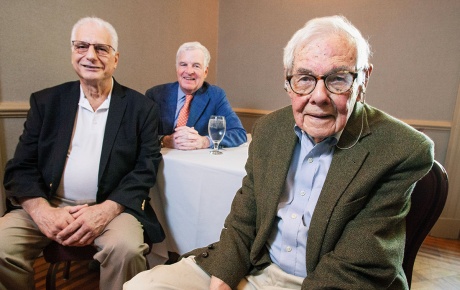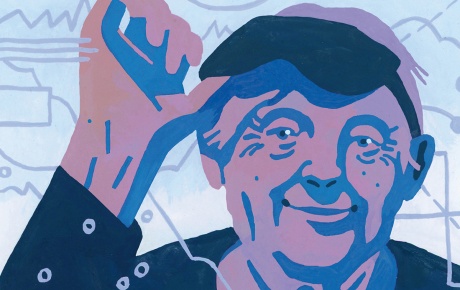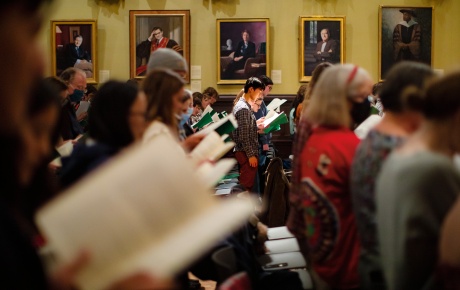But for all the new vistas the construction had opened up, for all the inviting stairways and plazas, something was missing. In the words of RISD professor Colgate Searle, the new spaces were "beautiful, but devoid of people." Tourists had little reason to do more than gawk briefly at the scenery, and locals seemed to be thinking: This is nice. Now what do we do with it?
Years of construction uncovered Providence's rivers and created a basin and amphitheater, Waterplace Park, heavily used in warm weather for boating in festivals.
Hardly anyone wonders that anymore. Today, the city's heavily strolled riverbanks and warm-weather sidewalk eateries are inviting comparisons to Boston and San Antonio. Those frequenting downtown Providence range from European and Asian tourists to Rhode Island suburbanites who formerly had steered clear of the city. And people are coming not just once, but again and again. The catalyst? Most urban observers agree that it was a breakthrough work of public art created by a Brown alumnus.
Barnaby Evans '75 is a Providence sculptor and photographer who creates, in his words, "site-specific artworks." The city's newly revealed rivers and their banks were as irresistible to him as a fresh roll of film in a Hasselblad. Evans's vision as artist and city dweller was to revive the urban pedestrian tradition. "I wanted to get Americans out of their cars, to get them downtown and walking," Evans says. "Once you have enough people outside, the city feels safe." To transform drivers and passengers into strollers, he turned to two primal elements: fire and water.
By New Year's Eve of 1995, Evans had installed a series of metal braziers in the Woonasquatucket and Providence rivers and piled them with fragrant stacks of scrap cedar and pine. After dark, Evans and a boatload of helpers went from pyre to pyre, lighting each in turn. The result was unexpectedly captivating. Crowds attending First Night-Providence loved the fiery spectacle of bonfires blossoming from the rippling, icy-dark waters; revelers hung over railings and thronged the paved embankments, murmuring and pointing for hours.
The following summer, Evans ex-panded the installation to forty braziers The event spawned repeat performances and sponsorship by a new nonprofit arts group. By the 1997 Water Fire season, 167 volunteers were helping to raise money and to light the fires every few weeks - people, Evans emphasizes, "from all walks of life - bankers, lawyers, homeless people, news anchors, artists, and a whole bunch of shrinks."
A latter-day tribal ritual, Water Fire with its intriguing taped music and fragrant cedar bonfires, is a magnet for awed visitors and delighted Rhode Island residents.
Shrinks? Local psychotherapists, Evans explains, began hearing about Water Fire from their patients, who praised its soothing qualities; intrigued, a half-dozen or so of the therapists signed on as helpers in order to better understand the phenomenon. One such volunteer, psychoanalyst Albert L. Dussault of Providence, de-scribed the event's visceral appeal in a letter supporting Water Fire's nomination for an environmental design award: "Mr. Evans used light, water, air, and fire to capture the urgency that is primitive in each of us....The incense of the wood burning, the convergence of light through the colors of the imaginary stained glass windows - the sky at sunset and the water reflecting fires - have filled the streets of Providence."
"Barnaby Evans is a genius," says Bob Burke, who owns two upscale city restaurants, Pot au Feu and Federal Reserve. Burke has criticized the riverbank redesign as being user-unfriendly and scarcely visible from most Providence streets. Evans, Burke believes, has rescued a flawed project. "Barnaby took a new urban endeavor," he says, "married it to a primal experience, and in the process created an event that people crave to be a part of." Not only that, but at a time of year - the dead of summer - when downtown restaurants ordinarily have to scramble for business, each Water Fire event has packed in the diners. Some restaurant owners, like Burke, got permission to close off city streets and add outdoor dining on Water Fire nights. "It's bringing people here in droves," Burke says happily. "We watch them come into our restaurants straight from the river with a serenity which is unusual."
At Waterplace Park, a late-summer festival offers music and a fine view of Providence's downtown skyline.
All summer and well into the cool evenings of last autumn, thousands of people - tourists, locals, couples, families - converged on the riverbanks at dusk to watch Evans's fires burn and to listen to haunting music wafting from speakers near the fires. Lately Evans has been out of town a lot, consulting with city officials nationwide hoping to recreate Water Fire on their own rivers. Evans is also working on a more ambitious scheme: to stage simultaneous Water Fires in cities around the world on New Year's Eve, 1999, to mark the milennium.
From College Hill, Brown students and employees have watched, in-trigued and sometimes bemused by the mess, as over the course of fifteen years, the face of Providence's downtown has changed. They've seen train tracks moved to the foot of the State House, where a modern station now serves travelers and Boston commuters. They've navigated construction detours around nascent buildings, including a convention center connected to a landmark neo-Gothic high-rise Westin Hotel, and a sleek office building and luxury apartment complex near the train station. The old train station facing Kennedy Plaza has been rehabbed into office suites and upscale restaurants.
But none of these changes was as dramatic as the river relocation project, in which workers dismantled what had been the world's widest bridge and rerouted the Moshasshuck and Woonasquatucket rivers to create a confluence just to the south of the Citizens Bank building. A tall World War I monument that formerly stood where the rivers now meet (and which was infamous as the center of a chaotic traffic rotary) is ensconced in a riverside plaza across South Main Street from the domed Old Stone Bank building, future site of Brown's Haffenreffer Museum. Nearby, the new College Street pedestrian bridge intentionally echoes the architecture of Brown's Van Wickle Gates, providing what architect Bill Warner calls "bookends" at the top and bottom of College Street.
Warner, who designed the waterfront reconstruction, has been a moving force for the project since the first feasibility study in 1983. "We realized that the city had two rivers joining a third river, and nobody knew it," Warner says. "If you think of other great cities with rivers - London, Boston - it's clear the potential we had here." So universally embraced was the notion of giving center stage to the three neglected rivers - the Moshassuck, the Woonasquatucket, and the Providence - that initial planning for the project was completed in near record time, Warner recalls. Within a year and a half, planners had secured city, state, and federal funding, and by late 1987 the actual work began. The final result, Warner says, has "gone beyond success. The first great event was when Joe Baer moved his canoe and kayak operation from South County to Providence. People began to go outside and eat lunch along the waterfront, to walk, to canoe - they were really using the rivers. And then Water Fire came along."
Providence isn't done yet. A huge mall is under construction near the State House; such luxury stores as Nordstrom's have signed leases. By the time that project is completed in August of 1999, well over a billion dollars in public and private money will have been invested in "downcity," as it's called.
Canoists paddle underneath a bridge spanning the entrance to Waterplace Park.
On warm days, the city's waterways are speckled with kayaks, Venetian-style gondolas, tour boats, and even the occasional skiff carrying urban fishermen. Jazz and rock music resonates in Waterplace Park during concerts and festivals from spring through fall. "We have recaptured the spirit of the city," exults Providence Mayor Vincent A. "Buddy" Cianci, Jr. "We've created new uses for urban space. It's a tremendous accomplishment for the people of Rhode Island."




